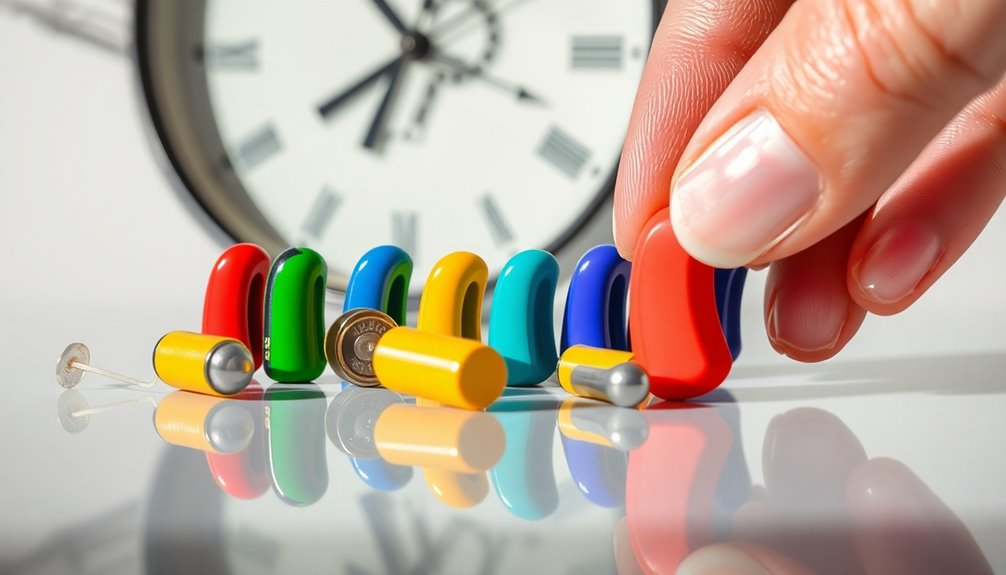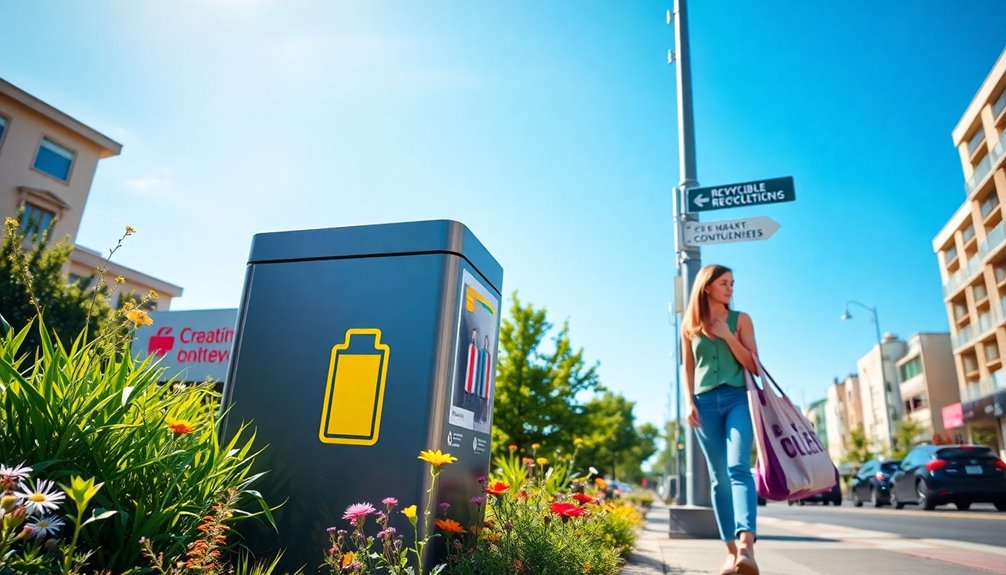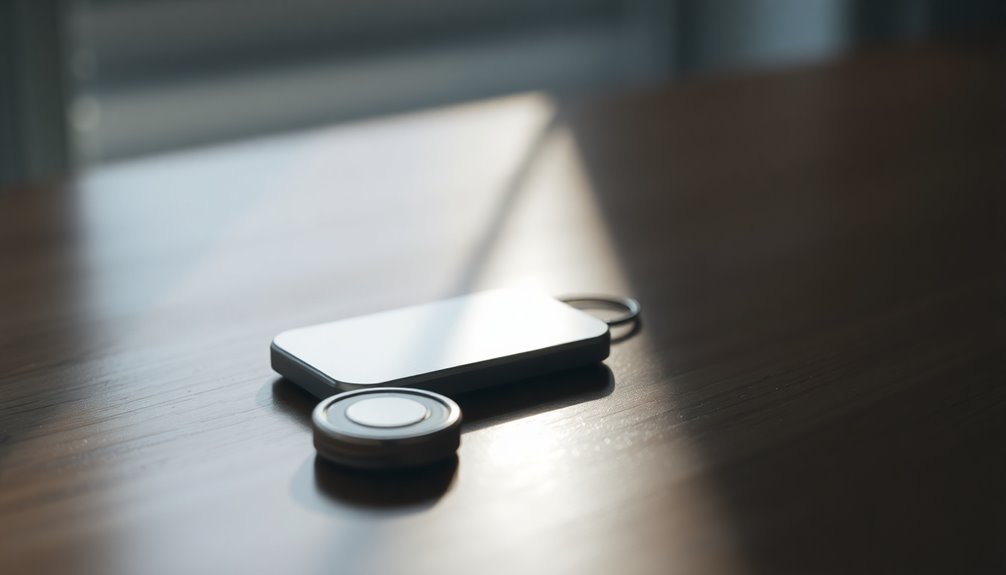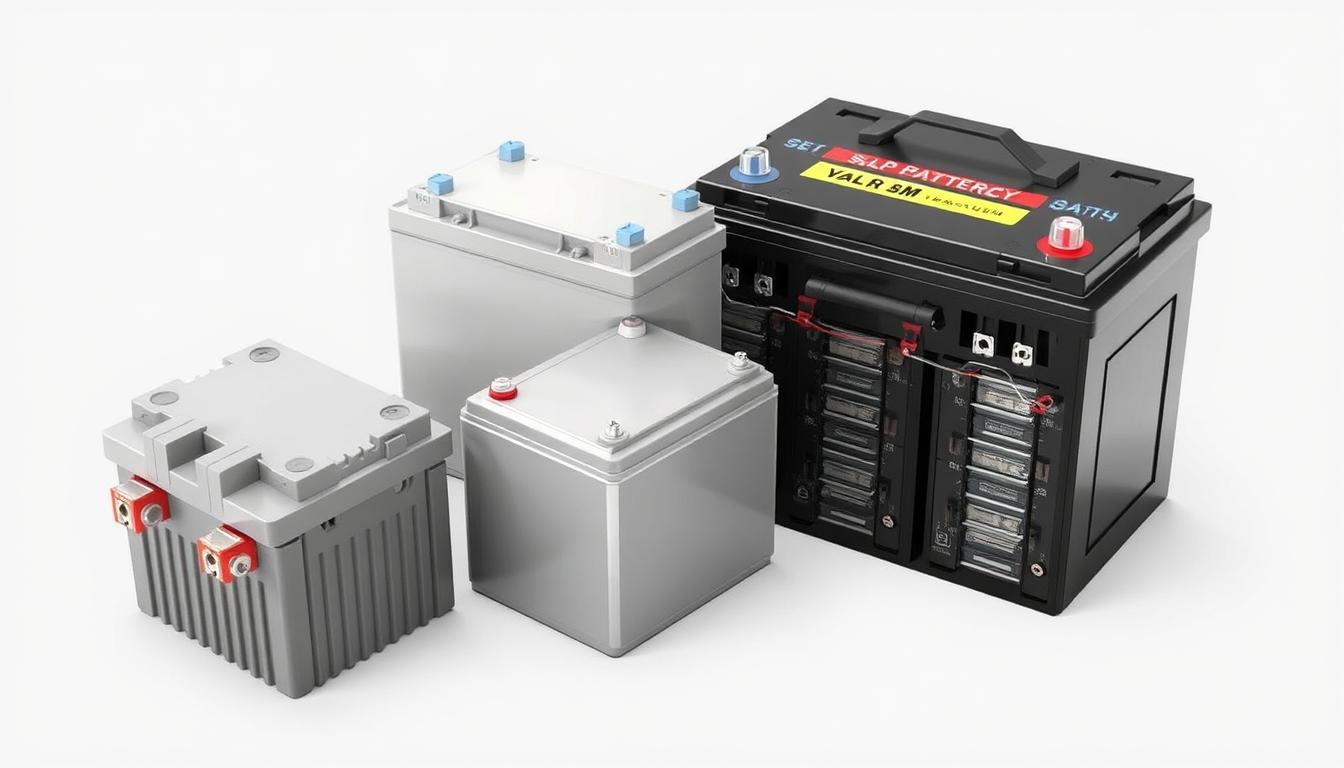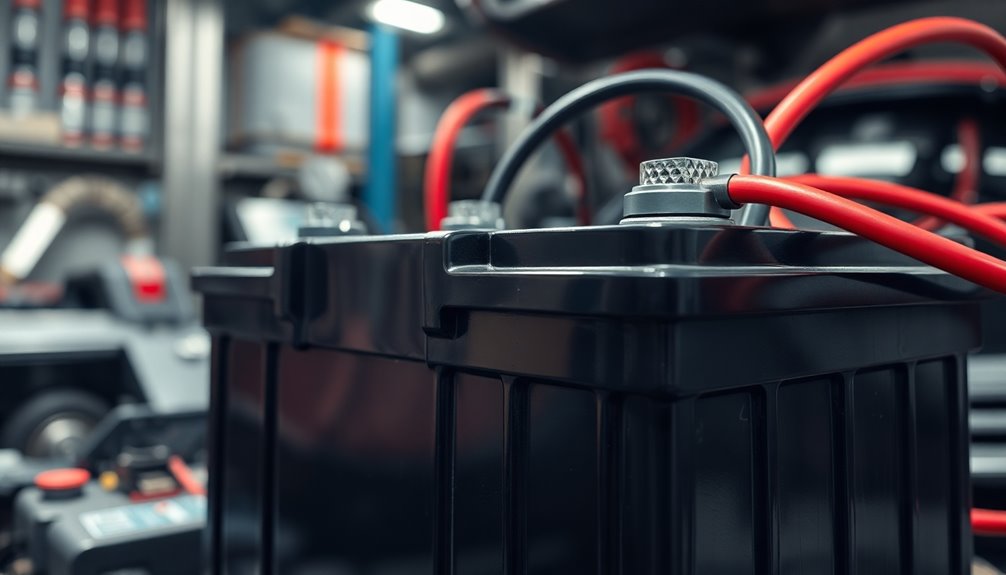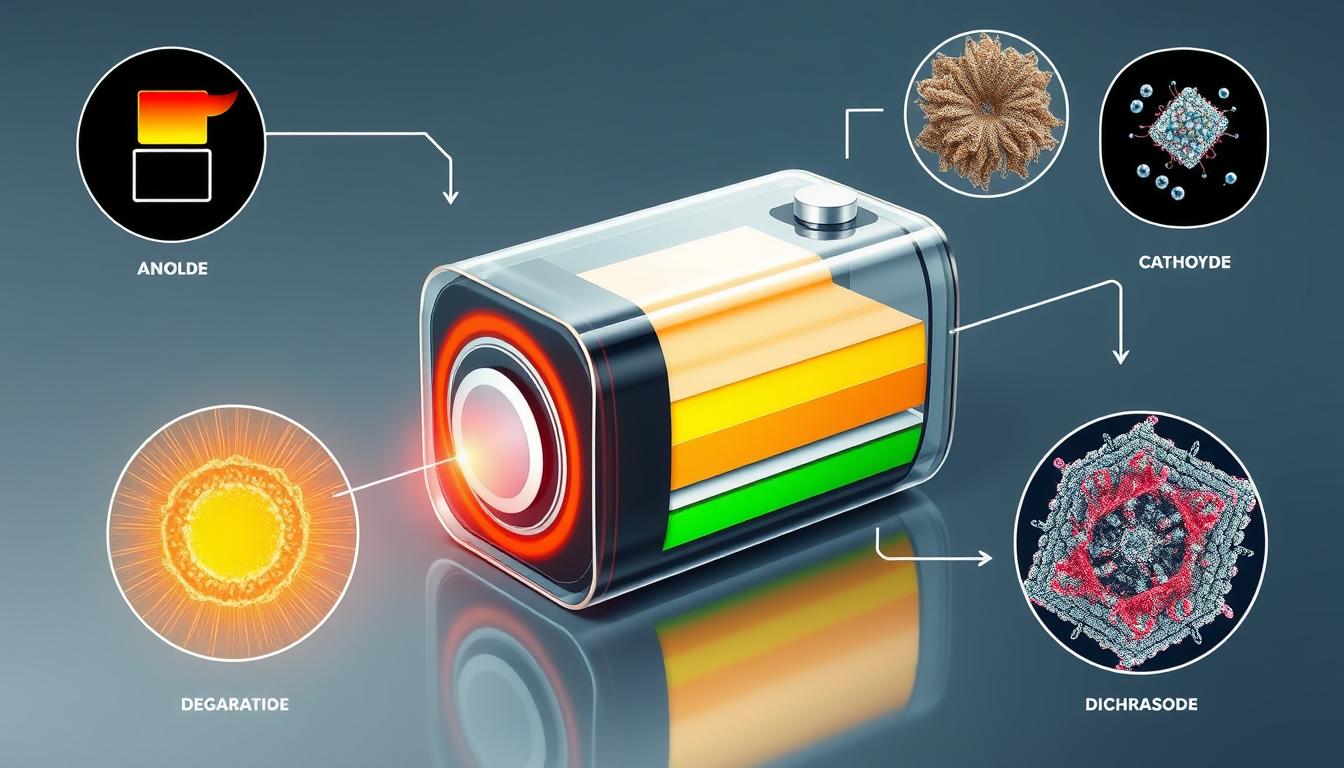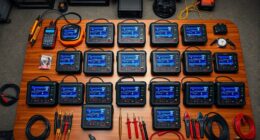Hearing aid batteries usually last between 5 and 14 days, depending on the size and your device. The size 10 batteries last about 3 to 7 days, while larger sizes like 675 can last up to 12 days. To extend your listening time, store batteries at room temperature, keep them dry, and turn off your aids when not in use. Regularly check for signs of low power, like distorted sound. Monitoring environmental conditions can also help improve battery life. You'll find even more tips and insights on how to maximize your battery performance.
Key Takeaways
- Hearing aid battery life varies by size: 10 (3-7 days), 312 (3-10 days), 13 (6-14 days), and 675 (9-12 days).
- Environmental factors like humidity and temperature can significantly impact battery longevity and performance.
- Always wait five minutes after removing the pull tab to ensure optimal battery activation and performance.
- Store batteries in a cool, dry place and check expiration dates to maximize freshness and lifespan.
- Regularly clean your hearing aids and keep them off when not in use to prevent battery drain.
Types of Hearing Aid Batteries
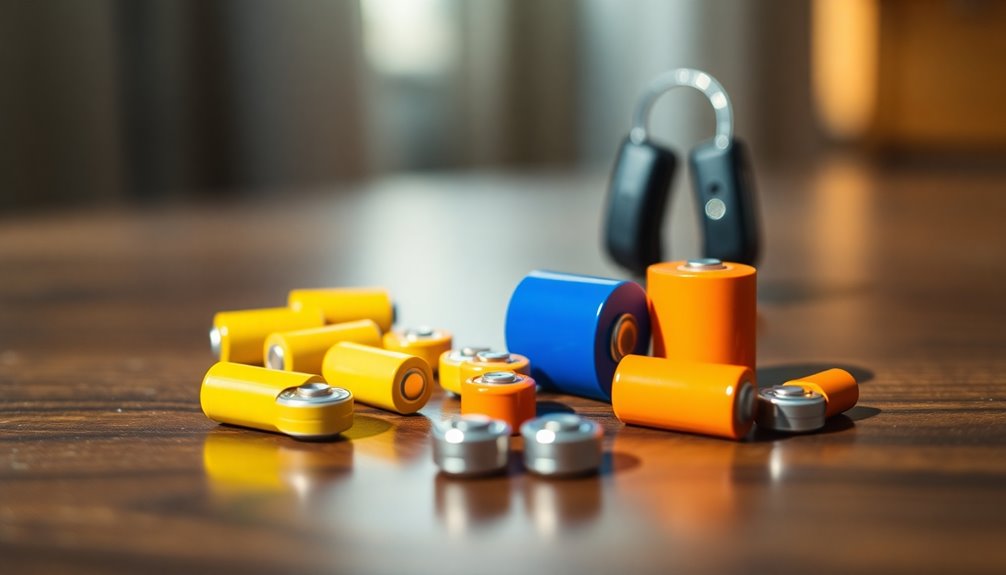
When it comes to hearing aid batteries, you'll find that most devices rely on disposable zinc-air batteries, which come in four common sizes: 10, 312, 13, and 675.
The battery size you need depends on your hearing aid's style and power demands. Smaller devices typically use size 10 batteries, while larger models often require size 675 batteries.
Zinc-air batteries use oxygen to produce power, and you'll activate them by removing the protective seal.
Battery life varies, lasting anywhere from 3 to 14 days based on usage patterns and features.
As a hearing aid user, you can easily find replacement batteries at drugstores, audiology clinics, or online, ensuring you've always got the power you need.
Characteristics of Zinc-Air Batteries
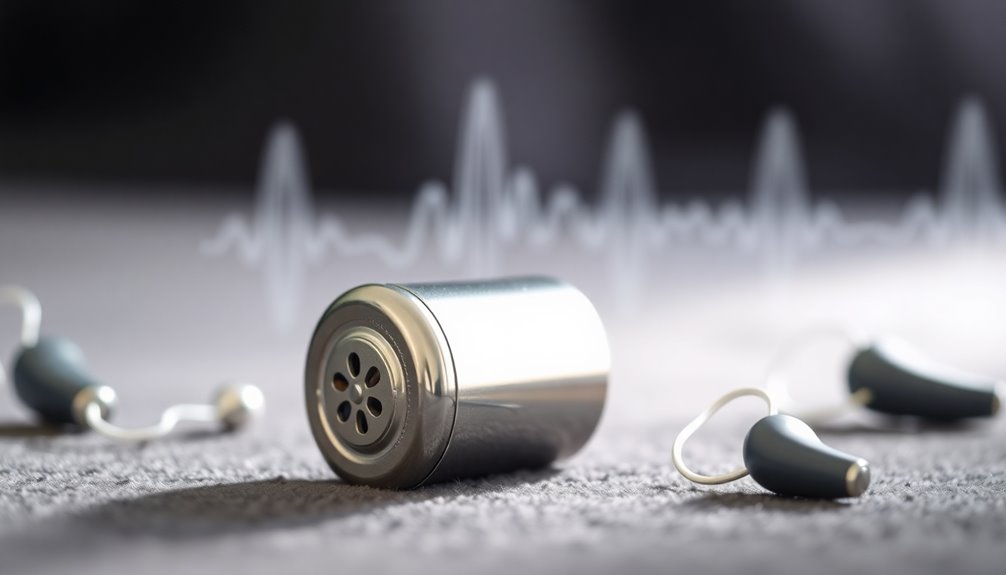
Zinc-air batteries are the standard choice for hearing aids due to their unique characteristics that set them apart from other battery types.
These disposable batteries require oxygen for power generation, making their activation process distinct. When you remove the protective seal, oxygen enters through tiny holes, so it's best to wait at least one minute before inserting the battery into your hearing aid for ideal performance.
Each battery is individually wrapped to prevent accidental activation, ensuring freshness until you need them. Proper oxygen absorption is essential for achieving the average lifespan of 5 to 7 days, which can vary based on usage and the type of hearing aid you use.
Embracing these characteristics enhances your overall battery life experience.
Average Battery Life Expectancy
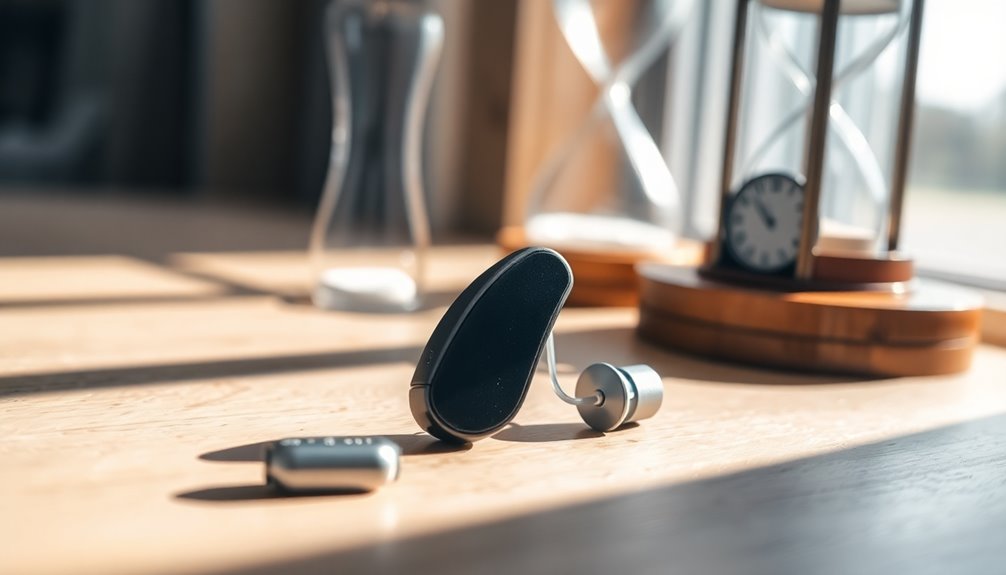
When it comes to hearing aid batteries, you can expect them to last anywhere from five to twelve days, depending on the battery size and your hearing aid style.
Factors like your degree of hearing loss and environmental conditions can greatly influence how long your batteries hold up.
Keeping an eye on their performance is key to ensuring your hearing aids function smoothly without unexpected interruptions.
Battery Lifespan Overview
Hearing aid batteries play an essential role in your auditory experience, and knowing their lifespan can help you stay prepared. The average lifespan of hearing aid batteries varies based on their size and type. Here's a quick battery lifespan overview:
| Battery Size | Average Lifespan | Type |
|---|---|---|
| Size 10 | 3-7 days | Non-rechargeable |
| Size 312 | 3-10 days | Non-rechargeable |
| Size 13 | 6-14 days | Non-rechargeable |
| Size 675 | 9-12 days | Non-rechargeable |
| Rechargeable | 20-30 hours (4-6 years) | Rechargeable hearing aid |
Understanding these factors affecting battery life and regularly monitoring battery performance can greatly extend your listening time.
Factors Influencing Duration
Battery longevity in hearing aids isn't just a matter of size; several factors come into play that can greatly influence how long your batteries last.
The average battery life ranges from five to seven days, but this varies based on the degree of hearing loss and frequency of use. If you frequently use your hearing aids in challenging listening environments, like noisy settings, you may notice a decrease in battery performance.
Additionally, advanced features like wireless streaming can drain batteries more quickly. To guarantee the best listening experience, keep an eye on your battery life and prioritize timely replacement.
Monitoring Battery Performance
Monitoring your hearing aid's battery performance is essential for ensuring you get the most out of your device. The average battery life for hearing aid batteries ranges from 5 to 12 days, depending on size and usage time.
For instance, size 10 batteries typically last 3 to 7 days, while size 675 can extend up to 12 days. You should always watch for signs of low battery, like distorted audio or low volume, and heed any low battery warning alerts.
Modern hearing aids often include built-in battery level indicators that you can check via smartphone apps, making monitoring battery performance easier. By being proactive, you can maximize your hearing experience and extend the life of your batteries.
Signs of Low Battery Power
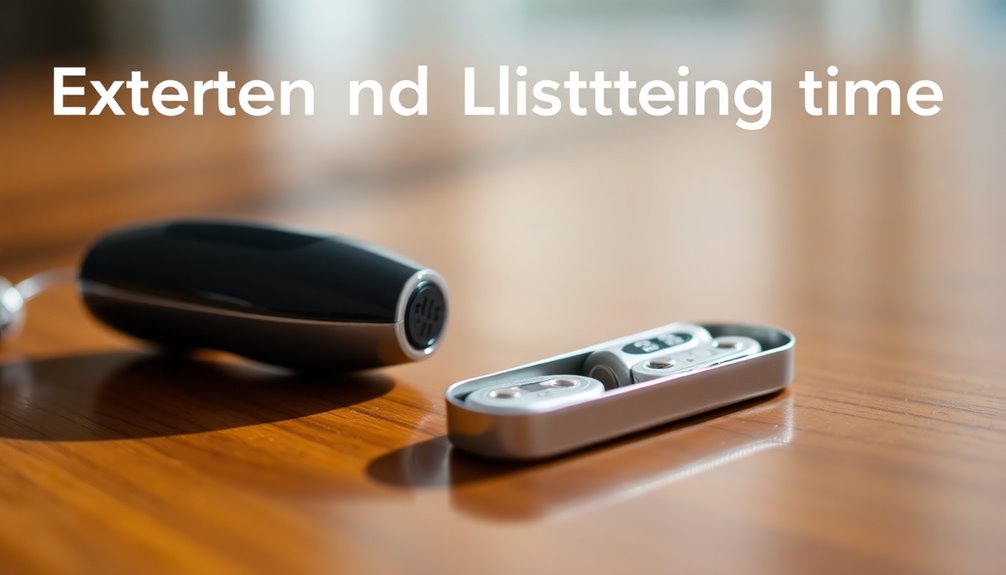
If you notice your hearing aid isn't performing as it should, it might be a sign of low battery power.
Common signs include the absence of sound, distorted or unclear audio, and unusually low volume levels. You may also hear an audible tone warning, indicating that it's time to change the battery.
Regularly monitoring battery performance is essential, as waiting too long can lead to your hearing aid stopping altogether. The battery needed depends on your usage and the device's size, so don't ignore these signs.
Tips to Extend Battery Life
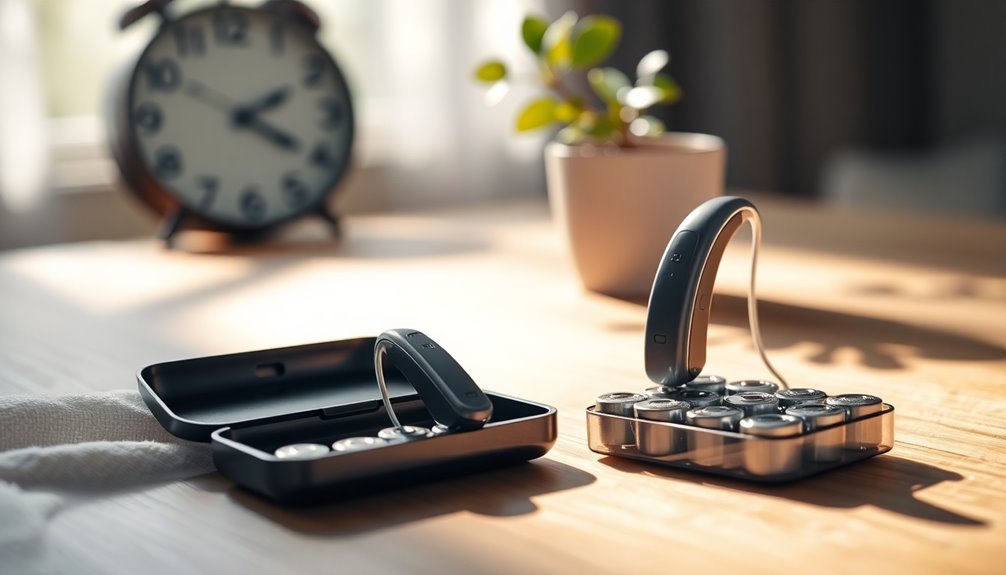
To keep your hearing aids functioning at their best, follow some simple tips to extend battery life.
First, store your disposable batteries at room temperature and away from moisture to guarantee peak performance.
When you're not using your hearing aids, turn them off and open the battery compartment to conserve power effectively.
Regularly clean your hearing aids to prevent debris buildup that can drain batteries faster.
It's also wise to keep a supply of spare batteries on hand for emergencies, and remember to check their expiration dates to maintain consistent battery performance.
Consider using a hearing aid dryer to protect your devices from moisture damage, which can greatly extend battery life.
Disposable vs. Rechargeable Batteries
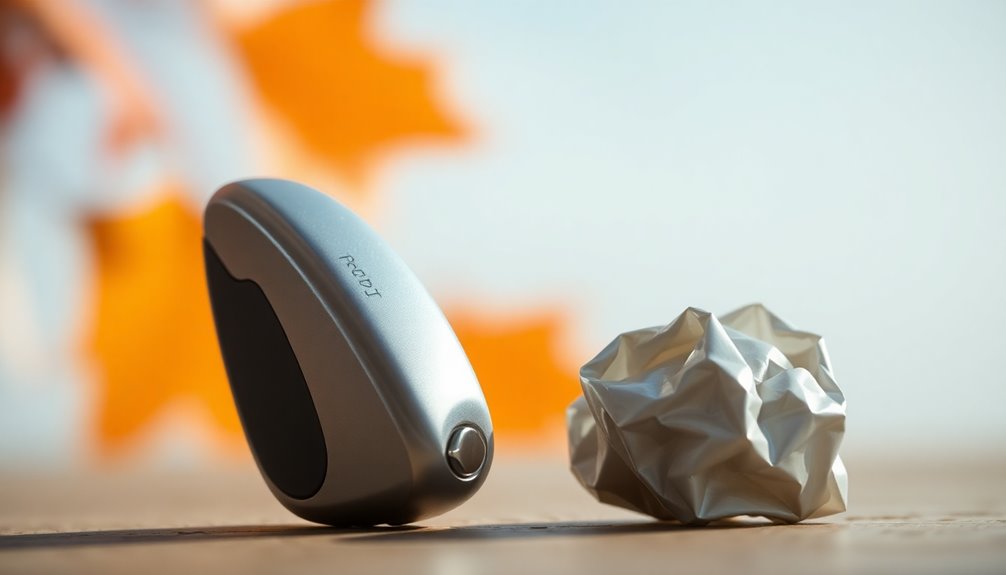
When choosing between disposable and rechargeable batteries for your hearing aid, consider their lifespan, cost, and convenience.
Disposable batteries might be easy to replace, but they add up in ongoing expenses, while rechargeable options offer longer use on a single charge.
Battery Lifespan Comparison
While choosing between disposable and rechargeable batteries for your hearing aid, it's important to understand their lifespan differences.
Disposable batteries, like zinc-air types, typically last between 3 to 14 days, depending on size and usage time. In contrast, rechargeable batteries offer about 20-30 hours of use on a full charge and can last 4-6 years before needing replacement.
Keep in mind that while disposable batteries require frequent replacements, monitoring performance is vital for both types. Heavy streaming features can drain rechargeable batteries faster, so nightly charging is necessary.
Ultimately, rechargeable batteries provide a more eco-friendly option, reducing waste and the hassle of constant changes, making them a popular choice among hearing aid users.
Cost and Convenience
Choosing between disposable and rechargeable hearing aid batteries often comes down to cost and convenience.
Disposable batteries are easy to replace and widely available, but they incur ongoing costs, averaging a lifespan of 5 to 7 days based on usage.
In contrast, rechargeable batteries offer 20-30 hours of use on a full charge and can last 4-6 years before needing replacement, making them a more cost-effective choice over time.
While disposables cater to various hearing aid styles, rechargeable options eliminate frequent purchases.
However, you'll need to remember to charge them regularly to maintain functionality.
Ultimately, consider your lifestyle and preferences to determine which battery type aligns best with your needs and habits.
Best Practices for Battery Maintenance
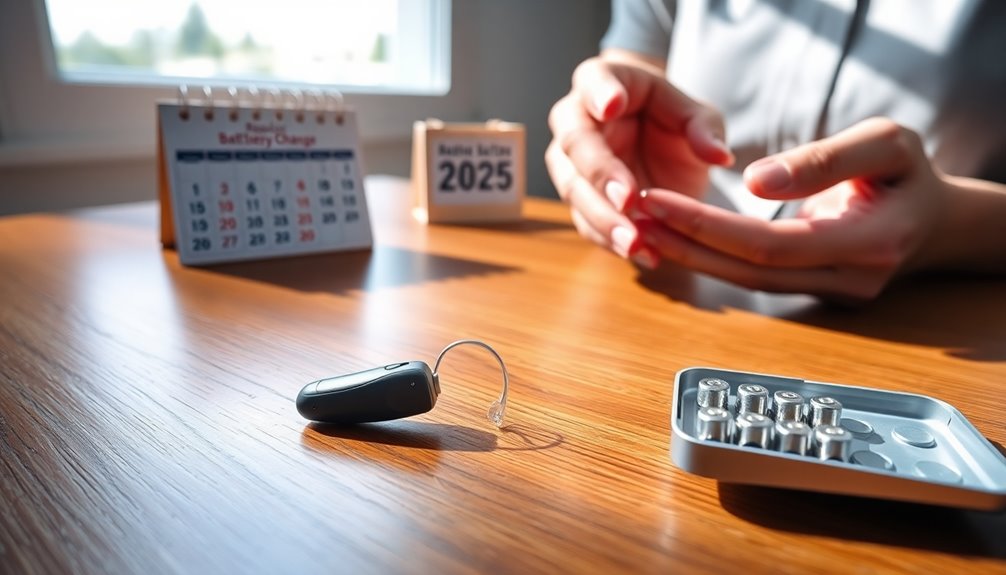
To maximize the lifespan and performance of your hearing aid batteries, it's essential to follow a few best practices. Start by removing the pull tab from disposable zinc-air batteries only right before installation and let them sit for at least five minutes for proper oxygen activation. Store batteries in a cool, dry place to prevent moisture damage, and always check expiration dates before purchase. Additionally, open the battery compartment of your hearing aids when not in use to conserve battery life. Using a hearing aid dryer or desiccant can further extend battery life by protecting against moisture buildup.
| Best Practice | Description | Benefit |
|---|---|---|
| Oxygen Activation | Wait five minutes post pull tab removal | Improves battery performance |
| Store Batteries Properly | Keep in cool, dry environments | Prevents moisture damage |
| Check Expiration Dates | Verify dates before purchase | Guarantees battery quality |
Environmental Factors Affecting Battery Life

Environmental factors play an essential role in determining the lifespan and performance of your hearing aid batteries. Understanding how environmental conditions affect battery life can help you manage your devices better.
Consider these factors:
- Temperature extremes: High heat accelerates battery discharge, while cold slows chemical reactions.
- Humidity levels: Dry air can lead to faster battery loss, while high humidity risks condensation and corrosion.
- Seasonal changes: Be mindful of how different seasons can impact battery efficiency.
- Storage conditions: Poorly stored batteries can lose their effectiveness quickly.
- Battery age: Older batteries may not perform as well regardless of other factors.
Importance of Moisture Control
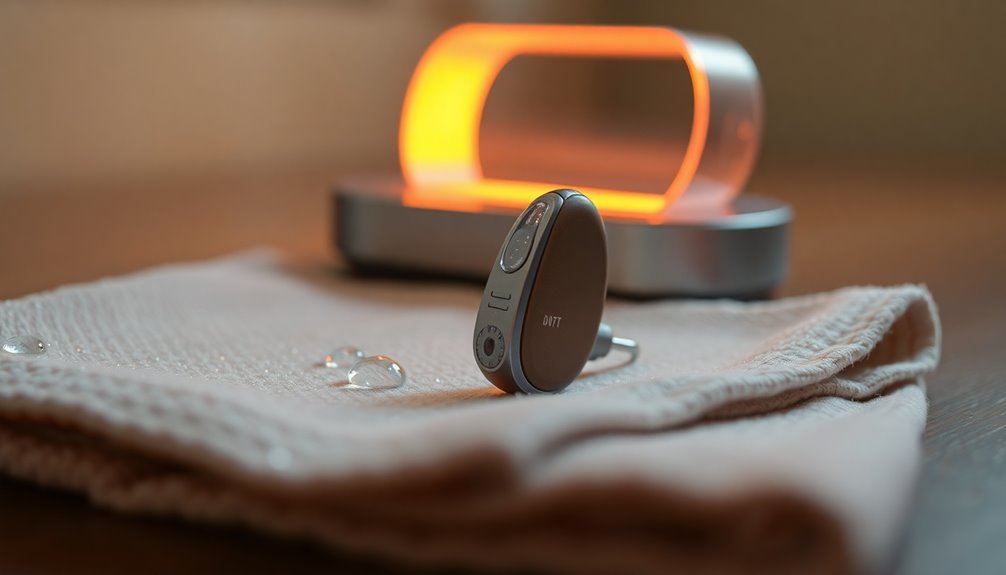
Moisture control is essential for keeping your hearing aids functioning well and preventing corrosion.
By managing moisture levels, you can maintain peak performance and extend your device's lifespan.
Simple steps, like using a hearing aid dryer and allowing airflow, make a big difference in protecting your investment.
Preventing Device Corrosion
Since humidity can wreak havoc on your hearing aids, controlling moisture is essential for preventing device corrosion.
Moisture exposure can lead to battery contact corrosion, negatively impacting performance and lifespan.
To keep your hearing aids in tip-top shape, consider these practices:
- Regularly check and clean battery compartments to remove moisture.
- Use a hearing aid dryer to protect your devices from humidity.
- Store your hearing aids in a cool, dry place when not in use.
- Avoid wearing your aids in very humid conditions, like during a rainstorm.
- Monitor your environment and adjust to reduce humidity exposure.
Maintaining Optimal Performance
To guarantee your hearing aids perform at their best, it's vital to manage moisture levels effectively. Excessive humidity can corrode the battery compartment, reducing sound quality and battery life.
Keeping your hearing aids dry guarantees peak performance, as moisture can damage electronic components. Consider using a hearing aid dryer to remove moisture after use, which protects your devices and extends the life of disposable and zinc-air batteries.
Additionally, always store your hearing aids in a cool, dry environment to prevent moisture accumulation, especially in humid climates. Regularly check and clean the battery compartment to avoid moisture buildup and guarantee dependable power delivery.
User Experiences and Insights
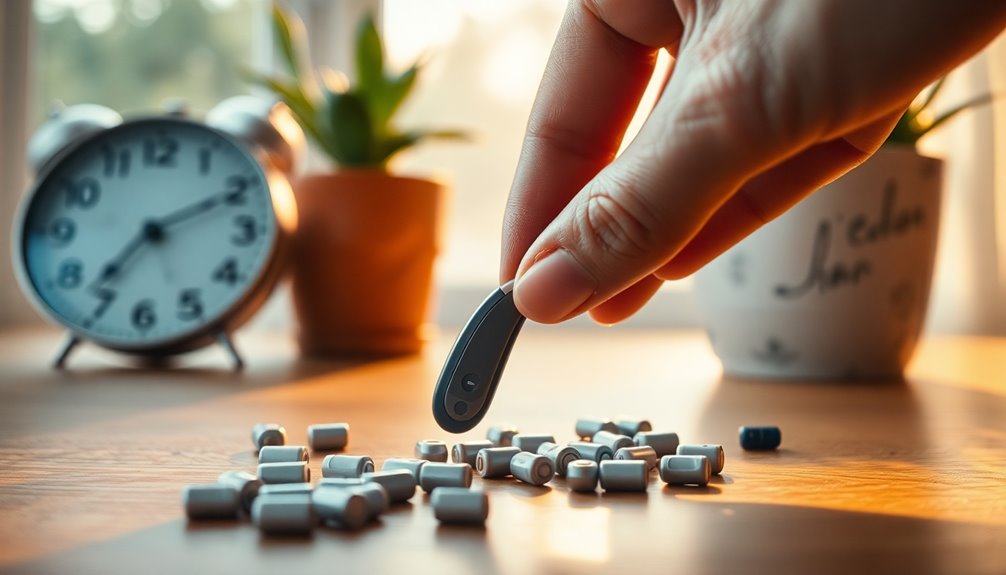
How do your daily habits affect your hearing aid battery life? User experiences reveal that small changes can make a significant difference.
Here are some factors that people have found helpful:
- Daily usage patterns and how often you wear your hearing aids
- Environmental factors like humidity and temperature that can drain batteries faster
- The choice between disposable batteries and rechargeable batteries
- Regular maintenance practices, like turning off devices when not in use
- Proper storage of batteries in a cool, dry place
Frequently Asked Questions
What Is the 5 Minute Rule for Hearing Aid Batteries?
The 5-minute rule for hearing aid batteries means you should wait five minutes after removing the protective seal from zinc-air batteries before inserting them into your hearing aid.
This waiting period allows oxygen to activate the battery, enhancing its performance and lifespan.
By following this rule, you can potentially extend your battery life by up to 30%.
How Many Hours Does a Hearing Aid Battery Last?
When you ask how many hours a hearing aid battery lasts, it really depends on several factors.
Typically, non-rechargeable batteries will provide power for 3 to 14 days, translating to roughly 72 to 336 hours, depending on the size and usage.
Rechargeable batteries, on the other hand, offer about 20 to 30 hours on a full charge.
Keep an eye on your battery performance to guarantee you're always ready to hear clearly.
How Much Does It Cost to Replace a Hearing Aid Battery?
Did you know that the average monthly cost for disposable hearing aid batteries ranges from $30 to $100?
When you're replacing them, keep in mind that prices usually vary between $1 and $3 per battery, depending on the brand and size.
If you consider rechargeable options, they might cost more upfront but can last 4-6 years, saving you money in the long run.
Always check for bulk discounts or insurance coverage to ease the costs!
Why Do My Hearing Aid Batteries Run Out so Quickly?
If your hearing aid batteries run out quickly, it could be due to several factors.
Higher degrees of hearing loss require your devices to work harder, draining batteries faster.
Environmental conditions like humidity and temperature can also impact performance.
Plus, using features like wireless streaming or noise reduction increases power demands, leading to quicker depletion.
Regularly monitoring your battery life and replacing them on time can help avoid unexpected outages during use.
Conclusion
To sum up, taking care of your hearing aid batteries is like nurturing a garden; with the right attention, they'll thrive and keep you connected to the world around you. By understanding the types of batteries, recognizing signs of low power, and following best practices for maintenance, you can greatly extend your listening time. Remember, a little effort can go a long way, ensuring you enjoy every moment without missing a beat.

